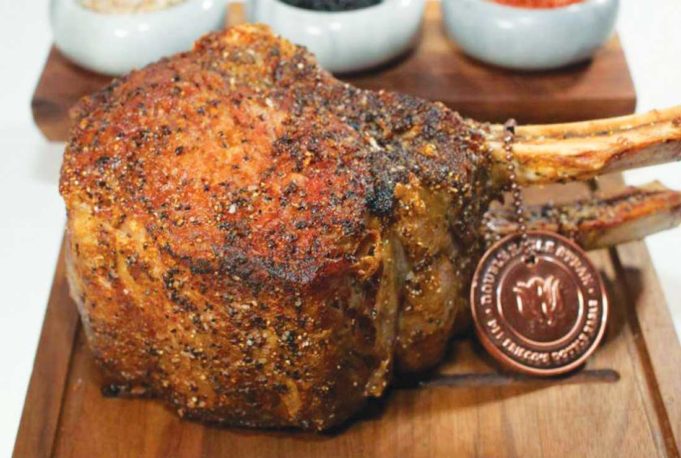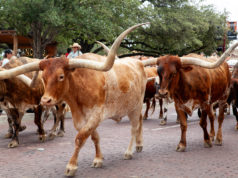If you look at the amount of attention and energy devoted to the dining scene, it’s hard to say that this isn’t a golden age. It’s not just that people are willing to spend more on their food, though they are. Right now, you can buy a $75 hamburger topped with caviar at Petrossian in Beverly Hills or a $150 burger with shaved truffles, wagyu beef, and lobster tail a few miles away at Nick and Stef’s. Closer to home, B&B Butchers & Restaurant offers a $220 steak flight, and Del Frisco’s Double Eagle Steak House’s 45-day dry-aged double-bone prime ribeye will set you back $125. These might have been put on the menu as gimmicks, but they’re actually being ordered.
Novelties such as this aside, there has been an explosion of places that offer wildly experimental dining experiences at nosebleed prices. Napa’s French Laundry, where a meal can easily top $500 per person, mainstreamed culinary combinations that never existed in any culture, and many others have followed. The creativity is undeniable, and to some people, it’s worth it. If you have an esoteric meal that you will remember years later, that changes the way you think about food, is that worth paying this kind of price? To some people, the answer is yes, and they are willing to travel long distances for peak experiences.
More importantly as a sign of our national evolution, in the last few decades, food from cultures all over the world is being treated with respect. This is true at all price levels and in all communities, and it is breaking down barriers in society. When the foodie crowd hears of a great dining experience, they’ll venture into neighborhoods they’d usually avoid for the bragging rights among their social group. Locally, food explorers (read: affluent white people) frequently find their way into minority neighborhoods in the north, south, and east sides just for the sake of an Instagram shot and a little street cred among fellow “photographers.” Both in traditional and fusion form, at budget cafes and pricy hotspots, there is interest in cuisines that were previously obscure. Some items have mainstreamed to the point where they’re now just another American food. Consider the evolution of the traditional Mex-Mex taco. It was only 20 years ago that you could find only hard-shell, ground beef-based, gringo-friendly versions of the classic item on local menus. Now, every bar in West 7th and downtown offers something that passes for authentic barbacoa or pastor. Twenty years ago, the average American had never tasted Pad Thai or Korean-style short ribs, and now you can buy both in the frozen section at Costco. Neither is as good as you’d be served at a real Thai or Korean restaurant, but the Costco meatballs aren’t as good as an Italian grandmother can make either.
Want further evidence of our fascination with food? I can tell you from personal experience that 20 years ago, if you photographed your meal in a restaurant, the entire staff was alerted that a critic was in the house. Nobody else did that. I bought a small camera and a jacket with large pockets, but sometimes I was still caught at it. Fast forward to now, and as soon as your plates arrive, at least one person at the table has a phone camera out. The shot is on the internet seconds later with a pithy comment. Food porn has been a thing since Gourmet Magazine pioneered luscious food photography in the 1940s, but it has become a sport of the masses. I don’t even need to mention how food porn and the moving image have combined to create multiple TV channels and untold numbers of video streams about experiences near and far, but I will anyway, just to remind people that the term “celebrity culinary explorer” would have been so much gibberish only a decade or so ago. The fact that Anthony Bourdain’s death affected so many people so deeply shows how he and his endeavors touched both the self-selected elite and the masses.
The obsession, one might even call it a mania, for all things culinary has spread to beverages. Classic cocktails went from drinks for old men to hipster accessories in an astonishingly short time, and new brands and flavors of the straight stuff proliferate. Beer became the new wine, and wine became a gold mine for boutique producers. Local draft cider is even a thing now. Farmers’ markets went from natural-food-enthusiast destinations to tourist attractions with live entertainment and food booths tucked between stalls doing a good business in arcane and beautiful produce. The fact that this could happen in an era when fewer and fewer people actually cook from scratch marks a trend that is almost countercultural. So does the rising interest in food history, both online and in person. Museums are scheduling culinary programs to woo foodies through the doors, and organizations of culinary historians that welcome amateurs are seeing an influx of curious younger members.
Essentially, we’re putting our creative energy, enthusiasm, and intelligence into thinking about food. How could anything possibly be bad about that? As a food writer and food historian, I can’t see a problem, but as a citizen I think I do. The obsessive interest looks a lot like a reaction to the strident, brutal, confrontational rhetoric that is all around us. Thoughtful, sensitive, and aware people are so repelled by current events that they tune out and seek something else. They may focus on food, music, sports, or some other passion, and that’s healthy if it’s really a respite from the daily grind and they reemerge invigorated.
I worry that they won’t. The people who flocked to Berlin cabarets in the 1930s to get away from the Brownshirts in the streets, or who attended Dada art shows in the new Bauhaus-style buildings, undoubtedly thought that sanity would return soon. The Romans who debated abstruse philosophy while Caligula declared himself a god were no doubt happy to ignore the crowned buffoon who was sinking deeper into madness. (And if anyone is casting a historical play about that era, I have a great idea for the costuming. It involves a wig in a color and style not found in nature.)
It’s unusual for me, a person who has put over three decades into the study of cuisine, to give this warning, but I have a platform, so I must do it. Escapism has its dangers. I urge you to go out and explore the cuisines of the world, our country, and our neighborhoods and teach yourself to recreate the items you like at home. While you’re in those restaurants and ethnic grocery stores, you might even try to learn a bit more about the culture that is represented, because while their food is mainstreaming, so are those people. They are our neighbors and citizens, too, and understanding them will be useful in the country we share. Go and learn, maybe check out some books on the topic, but at some point, shut the books and turn off the computer. Reengage with the world outside and put some effort into making it a better one. And after you do, reward yourself with a good dinner. You will have earned it.
Richard Foss is an author and historian who consults with museums on culinary programs.
Fort Worth Weekly associate editor Eric Griffey contributed to this story.












